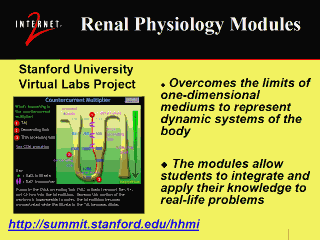 |
Current one-dimensional mediums
limit students’ ability to “see into” the dynamic systems of the body. To overcome
these limitations, the Stanford University’s Medical Media and Information Technologies
(SUMMIT) Project is developing interactive and simulation-based learning environments in
physiology for undergraduates at Stanford. Internet2 advanced networking will enable
future collaboration in curricula among member universities. The first module in renal
physiology contains a knowledge base in kidney structure, function, and difficult renal
concepts addressed in the traditional course material. Topics include auto regulation,
urinalysis, and countercurrent (cc) multiplier. The module contains a laboratory and quiz
section that allows students to integrate and apply their knowledge to real-life problems.
Finally, a resource section contains a glossary, previous lecture material, and a link to
an online office hours chat room. Future modules will include such topics as neuro,
cardiovascular, respiratory, and gastrointestinal physiology. |
